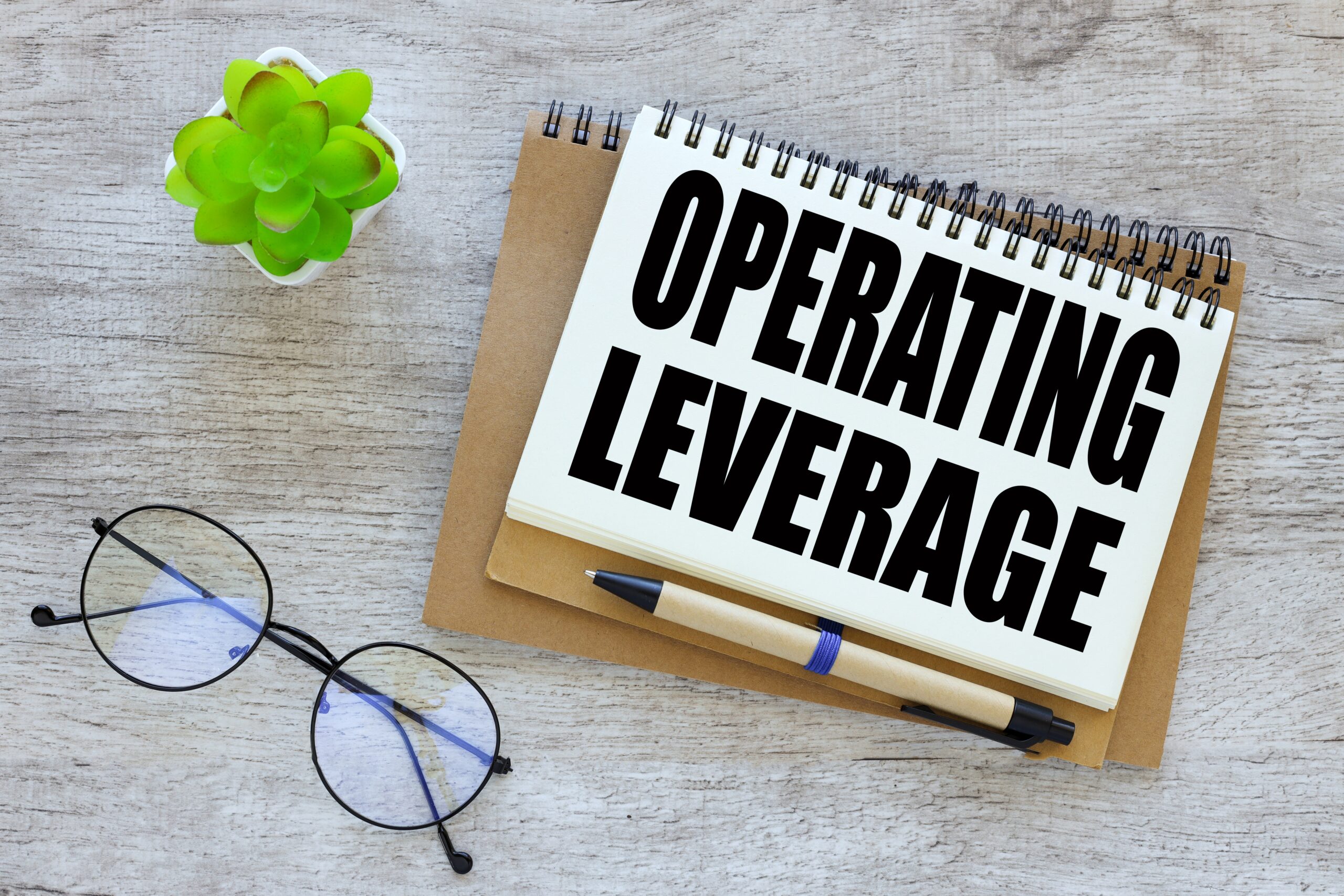What Is Operating Leverage and Why Does It Matter for Your Business?
- Posted in Financial Management / Strategy
- 10 mins read

In business, every decision—big or small—carries the potential to shape your bottom line. Among these decisions, how you structure your costs is crucial in determining your company’s profitability and resilience. This is where understanding operating leverage becomes essential.
Operating leverage refers to the balance between your fixed and variable costs and how this balance influences your ability to turn sales into profit. It’s a concept that directly impacts how much of your revenue contributes to covering fixed costs and, ultimately, profits. Whether you are running a startup or managing an established business, understanding this financial dynamic can provide valuable insights into your risk exposure and profit potential.
For example, think about a software company with high fixed costs from development and infrastructure but minimal variable costs per unit sold. Compare this to a retailer, where variable costs—like inventory—are a significant portion of expenses. These two businesses operate under very different cost structures, leading to different levels of operating leverage. Recognizing this distinction can help you make smarter financial and strategic decisions.
In this article, we’ll break down the key components of operating leverage, how to calculate it, and what it means for your business. Whether you are aiming to optimize your cost structure or scale your operations, understanding operating leverage is a crucial step toward achieving your business goals.
The Components of Operating Leverage
To fully understand operating leverage, it’s important to break it down into its key components: fixed costs, variable costs, and the contribution margin. Each of these plays a critical role in determining how your business responds to changes in sales.
Fixed Costs vs. Variable Costs
At the heart of operating leverage is the distinction between fixed and variable costs.
- Fixed Costs: These are expenses that remain constant regardless of how much you produce or sell. Examples include rent, equipment leases, insurance premiums, and salaried wages. Fixed costs don’t fluctuate with sales, meaning they must be paid even if your business isn’t generating revenue.
- Variable Costs: These are expenses that change in direct proportion to your sales or production levels. Examples include the cost of raw materials, sales commissions, and shipping fees. Unlike fixed costs, variable costs increase or decrease with your sales volume.
The balance between fixed and variable costs significantly impacts your operating leverage. Businesses with high fixed costs and low variable costs tend to have high operating leverage, while those with lower fixed costs and higher variable costs exhibit lower operating leverage.
The Contribution Margin
The contribution margin is another critical concept in operating leverage. It represents the amount of revenue remaining after variable costs are subtracted, which contributes to covering fixed costs and generating profit.
The formula for calculating the contribution margin is:
$$\text{Contribution Margin} = \text{Sales Revenue} – \text{Variable Costs}$$
For example, if your business sells a product for $50 and the variable cost per unit is $20, your contribution margin per unit is $30. This $30 goes toward covering fixed costs, and once those are met, the remainder becomes profit.
The contribution margin ratio provides additional insights by showing what percentage of each sales dollar contributes to covering fixed costs. This ratio is calculated as:
$$\text{Contribution Margin Ratio} = \frac{\text{Contribution Margin}}{\text{Sales Revenue}} \times 100$$
A higher contribution margin ratio means that your business retains a greater portion of revenue to cover fixed costs and generate profits.
Understanding these components—fixed costs, variable costs, and the contribution margin—is the foundation for analyzing operating leverage. They reveal how your business responds to changes in sales and help you assess whether your cost structure supports your goals.
Calculating Operating Leverage
Operating leverage provides a quantitative way to measure how sensitive your business’s operating income is to changes in sales. This sensitivity is expressed through a calculation known as the Degree of Operating Leverage (DOL). Let’s explore how to calculate and interpret it, step by step.
Degree of Operating Leverage (DOL)
The formula for calculating the degree of operating leverage is:
$$\text{DOL} = \frac{\text{Percentage Change in Operating Income}}{\text{Percentage Change in Sales}}$$
This formula measures the proportionate impact of a change in sales on operating income. A higher DOL indicates that your business’s profits are more sensitive to sales fluctuations, which is characteristic of high operating leverage.
In practice, DOL can also be calculated using the following formula when exact percentage changes aren’t available:
$$\text{DOL} = \frac{\text{Contribution Margin}}{\text{Operating Income}}$$
Here’s how each variable fits in:
- Contribution Margin: Sales revenue minus variable costs.
- Operating Income: Contribution margin minus fixed costs.
A Practical Example
Let’s consider a business with the following financial data:
- Sales Revenue: $100,000
- Variable Costs: $40,000
- Fixed Costs: $30,000
- Calculate the Contribution Margin
Contribution Margin = Sales Revenue – Variable Costs
$$\text{Contribution Margin} = 100,000 – 40,000 = 60,000$$
- Determine the Operating Income
Operating Income = Contribution Margin – Fixed Costs
$$\text{Operating Income} = 60,000 – 30,000 = 30,000$$
- Apply the DOL Formula
Using the formula $$\text{DOL} = \frac{\text{Contribution Margin}}{\text{Operating Income}}$$
$$\text{DOL} = \frac{60,000}{30,000} = 2$$
This DOL value of 2 means that for every 1% increase in sales, operating income will increase by 2%. Conversely, a 1% decrease in sales will result in a 2% drop in operating income.
Interpreting the Results
A high DOL indicates that your business can achieve significant profit growth once fixed costs are covered, but it also comes with increased risk. A slight downturn in sales could lead to a more substantial decline in profits. On the other hand, a low DOL suggests that your business is less sensitive to sales changes, offering stability but limiting the upside potential.
Understanding and calculating your DOL equips you to better evaluate the financial health of your business and make more informed decisions about scaling, pricing, and managing costs.
The Impact of High and Low Operating Leverage
Operating leverage significantly influences how your business responds to changes in sales. Whether you have high or low operating leverage, each scenario presents unique advantages, challenges, and strategic implications. Understanding these differences will help you align your cost structure with your goals.
High Operating Leverage
Businesses with high operating leverage have a cost structure dominated by fixed costs and relatively low variable costs. This type of structure can lead to significant profit growth after reaching the breakeven point, but it also comes with higher risks.
- Characteristics:
- High fixed costs (e.g., rent, salaries, depreciation).
- Low variable costs per unit sold (e.g., digital product distribution).
- Advantages:
- Greater profit potential as sales increase. Once fixed costs are covered, most additional revenue contributes directly to profits.
- Scalability benefits, especially in industries like software, where adding more customers involves minimal additional costs.
- Risks:
- Greater vulnerability to sales downturns. Since fixed costs remain constant regardless of revenue, a significant drop in sales can quickly erode profits.
- Longer time to breakeven, especially for startups with high initial investments.
Example: A software-as-a-service (SaaS) company with high development and infrastructure costs but minimal costs per additional user exemplifies high operating leverage. If sales increase, profits can grow exponentially, but a sales decline can result in significant losses.
Low Operating Leverage
Businesses with low operating leverage have a cost structure with lower fixed costs and higher variable costs. While these businesses may have lower profit margins as sales grow, they offer more stability during periods of fluctuating revenue.
- Characteristics:
- Low fixed costs (e.g., small-scale retail or service operations).
- High variable costs per unit sold (e.g., raw materials, hourly wages).
- Advantages:
- Reduced risk in times of declining sales. Since variable costs decrease as sales fall, losses are more manageable.
- Easier cash flow management because costs adjust with revenue levels.
- Risks:
- Limited profit potential due to higher variable costs, which reduce the contribution margin.
- Difficulty scaling profitably without fundamentally changing the cost structure.
Example: A small retail business that purchases inventory on-demand and employs part-time staff has low operating leverage. While profits are stable during slow sales periods, the business can’t easily achieve significant profit growth without increasing fixed costs or negotiating better supplier terms.
Choosing the Right Operating Leverage for Your Business
The ideal level of operating leverage depends on your industry, business model, and growth strategy:
- High operating leverage is well-suited for businesses that expect consistent or rapidly growing sales, as well as industries where economies of scale are critical.
- Low operating leverage is better for businesses in volatile markets or those prioritizing flexibility and risk management.
By understanding whether your business operates with high or low leverage, you can make more informed decisions about pricing, scaling, and managing risks.
Strategic Implications for Entrepreneurs
Understanding and managing operating leverage is more than a financial exercise—it’s a strategic tool that can shape your business’s growth trajectory and risk profile. As an entrepreneur, aligning your cost structure with your objectives and market conditions is essential to achieving long-term success.
Choosing the Right Cost Structure
One of the most critical decisions you’ll face is determining the balance between fixed and variable costs in your business. This balance directly affects your operating leverage and has far-reaching implications for how your business performs under different sales scenarios.
- When to Favor High Operating Leverage:
- If you operate in an industry with predictable and steady demand, such as subscription-based software, high operating leverage can amplify profitability.
- Businesses with high growth potential and scalable operations can benefit significantly from a high-fixed-cost model, where increased sales drive higher profit margins.
- When to Favor Low Operating Leverage:
- If your business is subject to seasonal fluctuations or economic volatility, a low-fixed-cost structure reduces the risk of losses during slow periods.
- Entrepreneurs in industries like retail or services often prioritize variable costs to maintain flexibility.
Scaling Your Business with Operating Leverage
Your operating leverage also plays a critical role in scaling. As you grow, the dynamics of fixed and variable costs can shift, and managing this transition effectively is key to maintaining profitability.
- High Operating Leverage Businesses: Scaling requires careful planning to ensure that fixed costs, such as new facilities or technology investments, are supported by projected revenue increases. Missteps in estimating sales growth can result in financial strain.
- Low Operating Leverage Businesses: Scaling typically involves adding more variable costs, such as inventory or labor, which can limit profit margins. However, this approach allows for a more gradual and less risky growth strategy.
Leveraging Operating Leverage for Competitive Advantage
Understanding your operating leverage can also help you make smarter strategic decisions to stay ahead of competitors:
- Pricing Strategy: Businesses with high operating leverage can use competitive pricing to attract more customers, knowing that each additional sale contributes significantly to profits.
- Cost Management: Continuously analyze your cost structure to identify opportunities for reducing fixed costs or improving variable cost efficiency.
- Market Positioning: Use your knowledge of operating leverage to position your business strategically within your industry. For instance, high operating leverage may allow you to dominate markets with high-volume potential, while low leverage might help you succeed in niche or volatile markets.
By integrating operating leverage into your strategic planning, you’ll be better equipped to navigate challenges and seize opportunities. The key is to balance profitability and risk while adapting to the unique demands of your business and industry. Whether you’re scaling up or optimizing operations, a clear understanding of operating leverage will help you make smarter, more informed decisions.
Share with:








